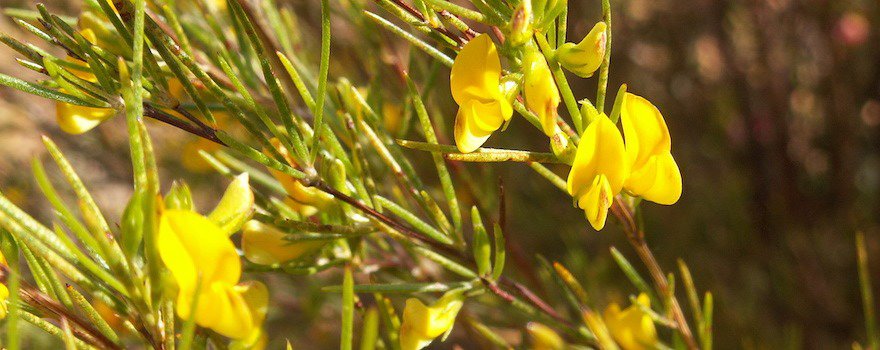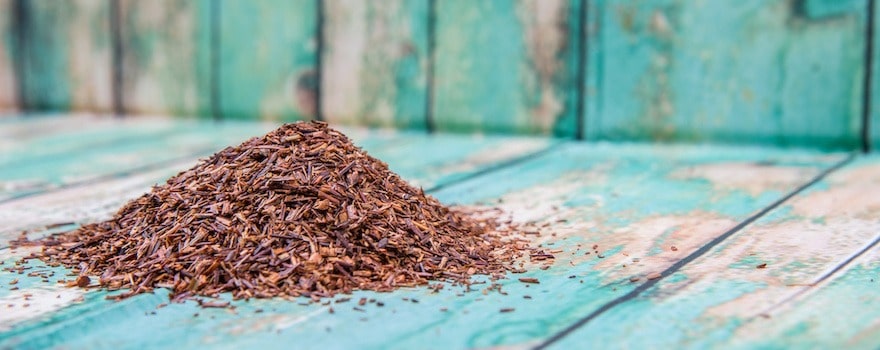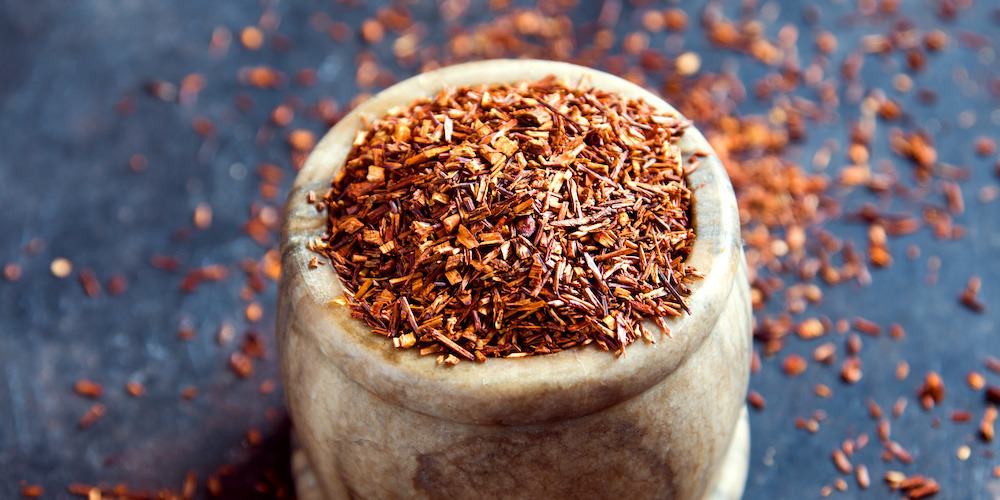BENEFITS OF ROOIBOS
✓ Exerts a cardio-protective effect
✓ Protects the liver
✓ Reduces blood sugar
✓ Relieves allergies
✓ Potentially anti-cancer
What is rooibos (or red tea)?
The rooibos (Aspalathus linearis), also called “red tea”, is a shrub of the Fabaceae family like beans, broad beans, mucuna, fenugreek or even griffonia. It has nothing in common with the tea plant (Camellia sinensis) and the teas we know. This is also why it does not contain caffeine. In this sense, it should not be confused with Chinese red tea or Pu-erh tea.
It grows in South Africa, in the Cederberg region. Located in the province of the Western Cape, it features many red, rugged mountains. It is here, in this remote and still wild place, that it originally grows.

It thrives in the hot and dry climate, sandy soil, and poor, acidic land. More rarely, rooibos can also be found on the semi-desertic high plateaus of Bokkeveld in South Africa.
The Aspalathus linearis can reach up to 2 meters in height. Thanks to its roots which can draw water up to 3 meters deep, it is able to withstand long periods of drought. From spring to the end of summer, the shrub is adorned with small yellow flowers.
It has fine, needle-shaped leaves which, before the plant dies, turn red. A peculiarity that earned the red tea the name “Rooibos” meaning “red bush” in Afrikaans.
The aerial parts (leaves and stems) have been used by local populations for centuries. Traditionally, red tea is consumed as an infusion, with milk and/or spices. It has been commercialized since 1930, and since the 1990s, the consumption of red tea has increased worldwide.
Rooibos is appreciated as a refreshing drink but also for its health benefits. In addition to being an antioxidant, it has anti-allergic properties, protects the liver and the heart, helps relieve intestinal and digestive disorders, and reduces blood sugar. Some studies have also highlighted its potential anti-cancer properties.
Nutritional Composition
- 15 amino acids including 2 essential ones
- Minerals and trace elements: magnesium, calcium, manganese, zinc, potassium, sodium…
- Polyphenols: aspalathin, nothofagin
- Flavonoids: catechins, quercetin, isoquercetin, rutin, luteolin
- Phenolic acids: caffeic acid, protocatechuic acid, ferulic acid
- Polysaccharides
- Essential oils

The benefits of rooibos
❤️ Exerts a cardio-protective effect
Red tea indirectly protects the heart by combating free radicals, oxidative stress, high blood pressure, and bad cholesterol. These are factors responsible for heart diseases such as atherosclerosis.
This action is due to the numerous antioxidants present in rooibos. The flavonoids, including quercetin and luteolin, are particularly beneficial for heart health. They inhibit the angiotensin-converting enzyme (ACE) which, by contracting the blood vessels, increases the blood pressure in the arteries. However, high blood pressure increases the risk of cardiovascular disease. That’s why, in conventional medicine, ACE inhibitor drugs are recommended for prevention and treatment of coronary diseases.
The aspalathin and nothofagin in red tea also act on TNF-α (tumor necrosis factor) involved in heart failure. Finally, rooibos improves the lipid profile by significantly reducing LDL cholesterol (or “bad cholesterol”) and triglycerides while increasing the level of HDL cholesterol (or “good cholesterol”). Thus, red tea prevents cholesterol accumulation in the arteries that leads to atherosclerosis.
This study from the Cape Peninsula University of Technology (South Africa), conducted on patients at risk of cardiovascular disease, shows the beneficial effects of red tea on the lipid profile.
This other study by various South African universities, conducted on diabetic rats, explored the cardio-protective potential of rooibos.
💎 Protects the liver
Red tea is interesting not only for prevention but also as a treatment for liver diseases (viral hepatitis, fatty liver, cirrhosis…).
Indeed, like matcha tea or guarana, rooibos contains a large amount of catechin. This flavonoid, antioxidant and heart-friendly, is also detoxifying and liver-protective. Thus, catechin contributes to the proper functioning of the liver, protects it, and improves toxin elimination.
Also read 20 foods to protect and cleanse your liver
Similarly, red tea modulates oxidative stress, responsible for liver damage, and suppresses the formation of pro-inflammatory cytokines involved in liver inflammation (acute or chronic hepatitis, hepatomegaly…).
This study from the Cape Peninsula University of Technology (South Africa), conducted on rats, shows how red tea alleviates liver lesions.
This other study from Comenius University in Bratislava (Slovakia), conducted on rats, demonstrates that Rooibos promotes liver regeneration after intoxication.
🍭 Reduces blood sugar
For several years, red tea has been studied for its effect on diabetes, particularly on blood sugar levels. Indeed, its leaves contain aspalathin, an antioxidant but also hypoglycemic flavonoid. It helps reduce the amount of sugar in the blood.
Moreover, like berberine, the aspalathin in red tea activates AMPK enzyme (AMP-activated protein kinase) involved in energy metabolism regulation. Finally, it allows better insulin sensitivity.
This study from the Tokyo University of Agriculture and Technology (Japan), conducted on mice, shows the anti-diabetic potential of aspalathin.
This other study from Sagami Women’s University (Japan), conducted on diabetic rodents, demonstrates that red tea reduces glucose levels in the blood.
🤧 Relieves allergies
Red tea has an anti-allergic action. Thus, it is particularly beneficial for relieving skin allergies as well as eczema and asthma.
This property is due to the presence of quercetin, a flavonoid also found in nettle leaves, ginkgo biloba, and moringa. Quercetin is a natural antihistamine: it can block the action of histamine and reduce allergic symptoms.
This study from Tomas Bata University of Zlín (Czech Republic), conducted on rats, shows the anti-allergic properties of quercetin.
🔬 Potentially anti-cancer
Red tea is currently the subject of research due to its anti-cancer potential and chemo-preventive activity. Its content of quercetin and luteolin makes it promising for inhibiting growth and inducing apoptosis (or programmed cell death) of tumor cells.
This study from various South African Universities, conducted on mice, demonstrated the chemo-preventive properties of rooibos.
This other study from Seoul National University (South Korea), conducted on mice, explored the action of certain African plants, including red tea, in the treatment of malignant tumors.
♻️ Relieves digestive and intestinal disorders
Red tea contains anti-inflammatory flavonoids like quercetin. Hence, it is useful in relieving inflammatory bowel diseases like ulcerative colitis and Crohn’s disease.
According to this review by the University of Mauritius (Mauritius) on African medicinal plants, rooibos is traditionally consumed to relieve colic in babies and stomach cramps.
Further studies are needed to evaluate the effectiveness of red tea in improving digestive and intestinal disorders.

How to consume rooibos?
Dried red tea leaves
Dried red tea leaves are generally available in bags or loose. They can be easily found in organic and specialized stores or online.
Rooibos is consumed as an infusion. Simply steep 1 teaspoon of dried leaves in 150 ml of water heated to 100°C for 5 to 10 minutes. In South Africa, red tea is usually accompanied by a splash of milk. Red tea infusion can also be enjoyed cold or iced, with or without honey.
The dried red tea leaves can be incorporated into various recipes to add flavor. Rooibos offers an incomparable taste, slightly sweet, between hazelnut and chestnut.

Red rooibos or green rooibos?
There are 2 varieties of rooibos: red and green. To prepare traditional red tea, the leaves and stems are crushed to remove the juice and break the fibers, then subjected to an open-air fermentation phase. They are then sun-dried for several hours.
Unlike red tea, the aerial parts of green rooibos are not fermented but directly sun-dried after harvesting. The antioxidant content is generally higher in unfermented rooibos. It has a more vegetal flavor and is less fruity. Additionally, it does not have the characteristic color of red tea because it’s the fermentation that turns the leaves from green to red.
Red tea and spices
Red tea pairs very well with certain spices such as ginger and cinnamon. Besides enjoying a delicious drink, you will benefit from their combined health benefits.
Even better, you can complement your red tea tasting with a few goji berries or açaí berries.
Consume sustainably: prioritize organic and fair trade rooibos

✓ We advise you to choose a red tea or rooibos that is certified organic, grown without chemicals. This is particularly important since the leaves will be prepared as an infusion. This will prevent pesticide residues in your drink! You will also enjoy superior quality and support environmentally friendly farming.
✓ True rooibos must come from South Africa. Although other countries have often been interested in growing red tea (Australia, United States, China…), attempts to grow it outside Africa have all failed. Note that rooibos now benefits from Geographic Indication (GI) status.
✓ Finally, favor red tea from fair trade channels. The cultivation of red tea is essential for many local producers in South Africa. Support their work by choosing fair trade Rooibos.
Dosage
⚖️It is recommended not to consume more than 3 cups of rooibos per day.
⏳Because it contains no caffeine, it can be enjoyed at any time of the day, including in the evening.
Red tea leaves should be stored in a dry place, away from light (ideally in a tea box).
🍵Infusion: 1 teaspoon of dried leaves in 150 ml of water.
Contraindications and side effects
Consuming red tea has some contraindications:
- Individuals with liver or kidney issues should avoid drinking red tea;
- Because Rooibos can reduce iron absorption, people with an iron deficiency should consult their doctor before consuming it;
- As red tea can interfere with chemotherapy treatments, cancer patients should also seek their doctor’s advice.
Excessive consumption of red tea may lead to the following side effects:
- Liver disorder.
- Increased estrogen production.
If you experience any side effects, stop consuming it and consult a doctor.
History, culture, and market of rooibos
A traditional and preserved culture
Rooibos grows in still pristine regions of South Africa. Although its leaves are harvested from the second year, the shrub produces abundantly when it is 4-5 years old. From January to May, producers can collect between 125 and 250 g of leaves and stems per plant and per harvest.
The production and development of a red tea plant then gradually decrease. When cultivated, it generally lives between 7 and 10 years. But in the wild, rooibos has a much longer lifespan, reaching up to 20 years!
South Africa produces about 14,000 tons of rooibos per year. According to this review by the Agricultural Research Council of South Africa, red tea is currently sold in over 37 countries worldwide. The United States alone already accounted for 86% of the export market in 2010.
Today, climate change, hotter summers, and drier winters threaten the cultivation of rooibos in South Africa.
File prepared by Julia Perez and Charlotte Jean
Sources and scientific studies
Marnewick JL, Rautenbach F, Venter I, Neethling H, Blackhurst DM, Wolmarans P, Macharia M, 2011. Effects of rooibos (Aspalathus linearis) on oxidative stress and biochemical parameters in adults at risk for cardiovascular disease.
Phiwayinkosi V. Dludla, Elizabeth Joubert, Christo J.F. Muller, Johan Louw, and Rabia Johnson, 2017. Hyperglycemia-induced oxidative stress and heart disease—cardioprotective effects of rooibos flavonoids and phenylpyruvic acid-2-O-β-D-glucoside
Olawale Razaq Ajuwon, Oluwafemi Omoniyi Oguntibeju, and Jeanine Lucasta Marnewick, 2014. Amelioration of lipopolysaccharide-induced liver injury by aqueous rooibos (Aspalathus linearis) extract via inhibition of pro-inflammatory cytokines and oxidative stress.
Ulicná O, Vancová O, Waczulíková I, Bozek P, Janega P, Babál P, Lísková S, Greksák M, 2008. Does rooibos tea (Aspalathus linearis) support regeneration of rat liver after intoxication by carbon tetrachloride?
Son MJ, Minakawa M, Miura Y, Yagasaki K, 2013. Aspalathin improves hyperglycemia and glucose intolerance in obese diabetic ob/ob mice.
Moe Sasaki, Nami Nishida, and Masako Shimada, 2018. A Beneficial Role of Rooibos in Diabetes Mellitus: A Systematic Review and Meta-Analysis.
Jiri Mlcek, Tunde Jurikova, Sona Skrovankova, and Jiri Sochor, 2016. Quercetin and Its Anti-Allergic Immune Response.
Magcwebeba TU, Swart P, Swanevelder S, Joubert E, Gelderblom WC, 2016. In Vitro Chemopreventive Properties of Green Tea, Rooibos, and Honeybush Extracts in Skin Cells.
Na HK, Mossanda KS, Lee JY, Surh YJ, 2004. Inhibition of phorbol ester-induced COX-2 expression by some edible African plants.
M. Fawzi Mahomoodally, 2013. Traditional Medicines in Africa: An Appraisal of Ten Potent African Medicinal Plants.



